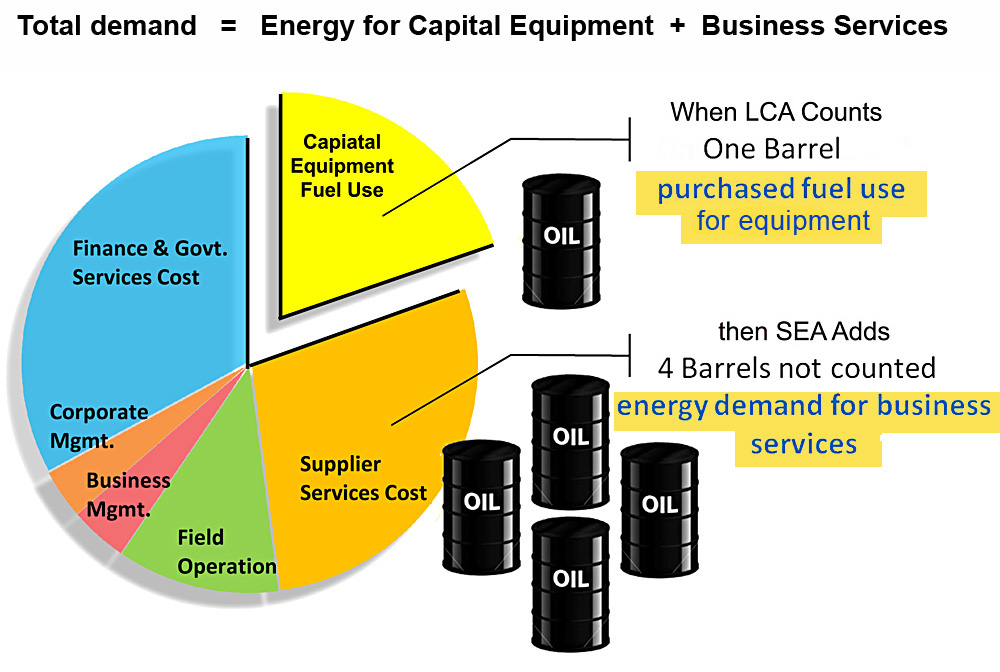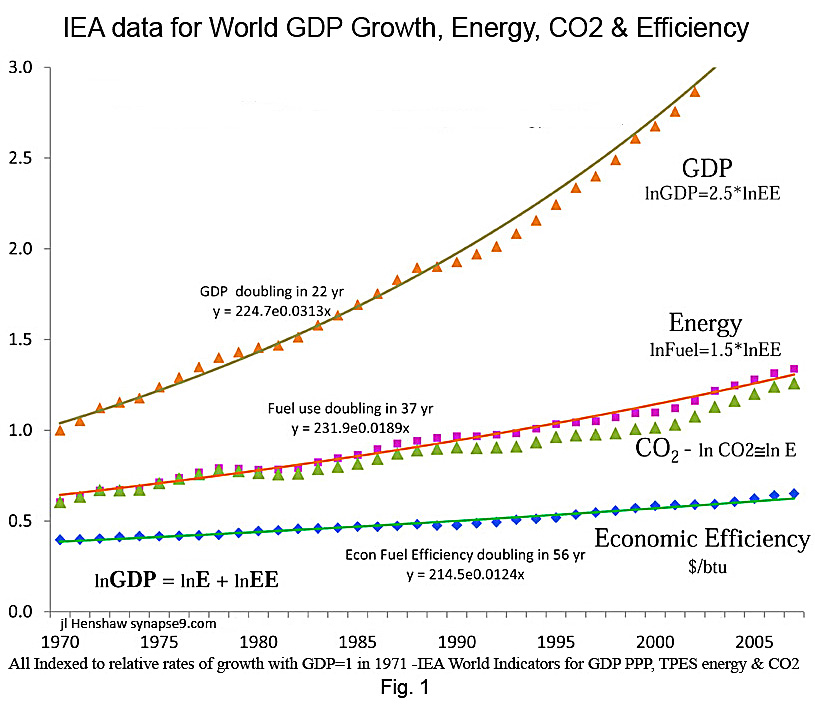10/26/12 in Shining Light on “Dark Energy”, part of my “reality math” series, I describe how standard measures of business impacts vastly under-count them, and how it has equally misled our theory and practices of sustainable design.
We’re not counting the consumption required to deliver business services at all, and that’s commonly much larger than the impacts we can trace directly. The article is in the Sept 2012 SB “New Metrics of Sustainability” letter (& here as a PDF). The research for it is the peer reviewed 2011 SEA assessment method published in Sustainability (MDPI). In discussing it on Systems Thinking World I found good added ways to explain the huge problem it causes us. The graphic below shows the scale of the error, the typical four-fold under-count.
But… Why Does the Changing Information Matter ???
Loraine noted that if the same error of perception is the same for all, it might not matter, for example. So, the problem that misinformation distorts every decision you make wasn’t getting through. The question she asked help set up a good explanation.
________
10/25/12 Loraine – Thanks for inquiring. I do recognize there is something in my work that is hard to connect with. Maybe its best exemplified by the weird quotes I get occasionally, like my dad’s, the outstanding physics professor who taught me to be so observant I could recognize behavior not following the laws of physics. He finally gave up in exasperation saying “Everything you say is true dear, it’s *just not physics*”. Needless to say, I also had no idea what to say to a response like that!!

But that was years ago, and I do see a lot more clearly what keeps people from recognizing how I depart from the common perspective. I am, after all, talking about systemic errors in perception. In this case it’s for the world’s standard setting bodies for economic measures. They’ve been thinking our data was the reality, unaware of how much of business system impacts are hidden from view. Thinking our information is reality is a problem lots of places. You’re right that if the quite large error found in measuring the impacts of businesses was the same everywhere it wouldn’t matter at all. I think I would have said “commonly 500%”, just to characterize the scale. It does vary a good bit, but size really matters here too! Partly it says we’ve been just asking the wrong question entirely. If you read a couple pages of the article you know that what businesses have no impact records for is all the services they pay for to operate. Those impacts are roughly proportional to their financial costs, as all costs filter down to being average human consumption. So the impacts overlooked were nearly all of the ones incurred by their use of money, having no information about that! In trusting their misinformation they ignored the impacts of the money used to pay for someone to operate the technology, or for someone to build their technology… really. In deciding that the records of energy use for technology were the only energy demands of businesses, they completely ignored that the use of money creates demands for energy uses and other impacts,. So, working with such incomplete models and data to develop models for sustainable practices, people have not actually been thinking about the systems for which they were designing. To make money they did what you’d expect. It’s entirely innocent, I think, but they ended up making small decreases in the small part of the impacts being recorded, making that their selling point, to market projects with increased hidden impacts. Making those choices is entirely natural if your motivation is to “make more with less”, unaware what a huge contradiction “making more knowing less” really is . It does make sustainable design unsustainable, though. I apologize for being repetitious in offering up things as people sniffed at but ignored them time and again, but sustainability is impossible if we misunderstand what we’re doing so completely. It helps that you asked. JLH
__________
10/23/12 How Loraine posed the question was:
Jessie, It seems that, even though you’ve been posting this paper and its predecessors in a number of threads, you haven’t been able to “sell” your concept here. Perhaps it’s because you haven’t tapped into our “deep values” in a way we can understand, or shown WHY we should care about your method.
You stated that “virtually ALL the data on which the sustainabilty community bases its methods on, are off by a full magnitude of scale.” Is it just a constant error, so that it doesn’t matter anyway? Or are some businesses “worse” than others? And, if so, HOW and WHY are they worse? What is the REAL “bottom line” conclusion that people should draw from the paper? That people shouldn’t work because they use energy? That wind farms are bad for the world because they use much more energy than people originally thought? Or, alternatively, that it’s good that wind farms are less efficient than people thought because we need to be inefficient because efficiency causes more growth (Jevons Paradox)? How does your paper advance our understanding of what we SHOULD be doing that we’re not, in terms of helping humans learn to co-exist with the rest of nature? If you make those points clearer at the onset, then people will likely better understand why your method might be useful to them/us. Thanks!
___________
10/26/12 posting note
If you want it in a much more compact version, it’s that money launders the information we need on the energy uses contributing to our products. So, to understand how our world works we need to think of:
Energy Use = Dollars Paid
The raw data that proves it globally, and Jevons’ so called “paradox” of efficiency and growth too, is displayed in the following image also from the SEA study. If you start with this hard data on total energy use, it help you study the details, keeping you from skipping over the big long chains of energy uses that would be hard to see otherwise.

